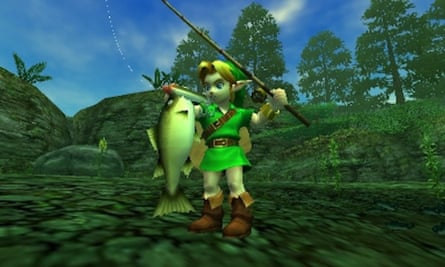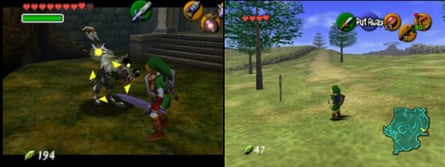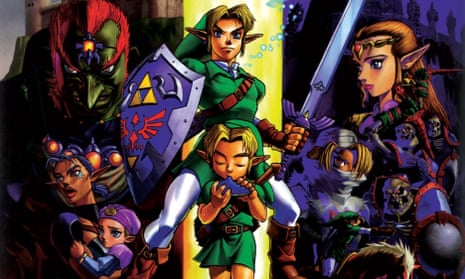The Legend of Zelda: Ocarina of Time’s opening sequence is, for me, the most evocative of all video games. First you hear the galloping of a horse, joined by soft major-key piano and melancholy, soaring ocarina notes as a young man in a green tunic rides under the setting moon. The camera pans over a blocky, low-resolution, yet spartanly beautiful landscape as the sun rises. It prepares you for a game that could be as melancholy as it was exciting, as emotionally affecting as it was technologically innovative. Released in Europe on this day in 1998, Ocarina of Time was one of the first true 3D adventures, a capsule world on a game cartridge, and it remains one of the very best.
It’s a dark story, when you think about it. Link, a child growing up in the forest, has his identity and his childhood stolen from him as he discovers that he is not the elf he thought he was but an orphaned Hylian boy. Given the grave task of stopping a wicked man whose hunger for power will corrupt the entire world, he is imprisoned for seven years in a temple, reawakening in the body of a man to find that the world has nearly ended. The vivacious land of Hyrule that he knew is gone, replaced by a devastated ruin crawling with monsters under swirling, menacing skies. The N64’s low-poly visuals lent the whole thing a surreal patina, like something half-imagined and half-remembered. Its sort-of sequel Majora’s Mask, released in 2000, leans fully into the surreal, vaguely nightmarish, end-of-the-world vibe of Ocarina of Time’s darkest moments.
For a game often remembered as a childhood classic, Ocarina of Time is pretty damn scary. Link’s nightmares, his serious little expression in the face of his heavy responsibilities, the shuddersome monsters of the Shadow Temple – all of this was thrillingly eerie to anyone who played Ocarina of Time as a child themselves. Remember the Gibdos, those awful mummies that could freeze you on the spot with a shriek, approaching Link with dreadful slowness before leaping suddenly to wrap their arms around his neck? Or the house of Skulltulas, where a family had merged horrifyingly with skull-faced spiders? Absolute nightmare fuel.

And yet Ocarina of Time is also joyful. Most players remember the first time they walked out into Hyrule Field, the rousing theme, the sudden opening-up of possibilities and adventure, the exciting realisation that you really could go in whichever direction you fancied. Galloping around on Epona, Link’s horse, was incomparably freeing. Kakariko Village bustled with life, full of weird people to chat with and local mysteries to investigate. Downriver, the aquatic Zoras had built a stunning amphibious world of their own; on Death Mountain, rock-munching Gorons could be discovered in their mountainside homes. Video games had simply never been like this before.
Composer Koji Kondo’s extraordinary score ranges from menacing to melancholy to playful to triumphant, tracking Link’s journey from brave, lonely child to tragically fated adult and back. Merely seeing the words “Fairy Fountain” or “Lost Woods” instantly brings the relevant music to mind, decades later – and of course, the player contributes to the soundtrack themselves with Link’s ocarina. Playing songs with notes mapped across the N64’s odd three-pronged controller, you could summon storms or the sun, befriend frogs and horses, and unlock secrets in magical places.

Given that Ocarina of Time was one of the first truly 3D adventures, it is extraordinary how well it was executed. The Z-button lock-on made fighting with a sword and shield, talking to characters and focusing the camera on what you needed to be looking at easy in 3D space. The sword combat still feels exciting and balletic, especially against the lizard warriors and skeletal guardians that lurked inside the later temples. Our time in Hyrule was measured by those intricate palaces of puzzles and mysteries, each built around a single weapon or ability that transformed Link’s ability to interact with his world and forced you, the player, to think more creatively. Coloured tunics protected him from extreme heat and let him breathe underwater; bombs let you knock through walls to find secret paths. In the memorably labyrinthine and perplexing Water Temple, hookshots and lead boots had you trying to wrap your head around altered laws of physics.
Some of those temple bosses are especially vivid in the memory. A giant lizard lurked deep within Death Mountain’s temple, and could only be stopped by throwing bombs down its gullet. At the end of the Forest Temple, Link finds himself locked in a creepy room of hung portraits, frantically scanning the landscapes with bow drawn, searching for the ghoulish phantom echo of Ganondorf thundering towards him on his menacing black steed. And in the game’s final confrontation, Link plays a desperate game of magical tennis with the evil man himself, batting balls of magical energy back and forth with terrifying alacrity, waiting for a chance to strike with the sword.

Ocarina of Time remains eminently playable today because so many of the things it invented became standard for any 3D game that came after it. All Link’s various actions can be performed with one or two buttons, greatly simplifying the act of interacting with virtual worlds. Even games such as Red Dead Redemption 2 use some version of Z-targeting. Navi the fairy provided a contextual hint system, as well as some company while Link made his lonely way towards his destiny. (Her desertion of Link at the end of the game, after he has saved the world and returned to his child’s body, seems sadder and sadder the older I get; the fairy is, after all, the only one who knows what he has accomplished.)
It is also an understated and powerful story, with the imagination of a fairytale and the gravitas of a legend, told not just through the cinematic cut-scene techniques that were dominant in ambitious games of the time or the abundant text storytelling fleshing out games that came before it, but also through its mysterious, inviting and memorable world.

Comments (…)
Sign in or create your Guardian account to join the discussion